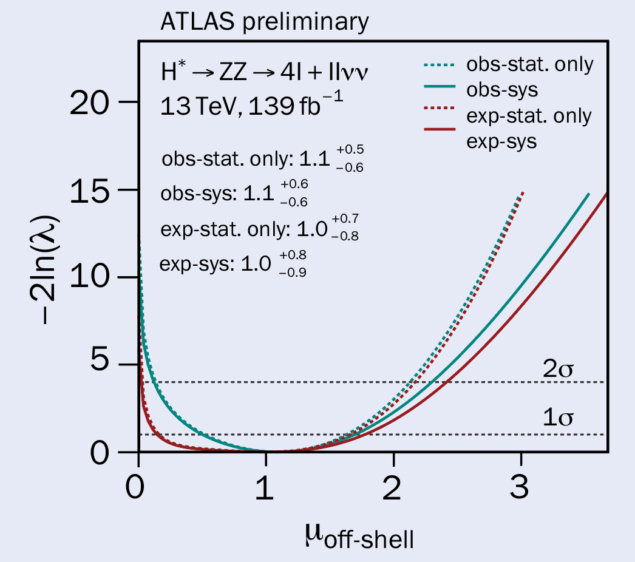A report from the ATLAS experiment.

Studies of the Higgs boson by ATLAS and CMS have observed and measured a large spectrum of production and decay mechanisms. Its relatively long lifetime and low expected width (4.1 MeV, compared with the GeV-range decay widths of the W and Z bosons) make the Higgs boson a sensitive probe for small couplings to new states that may measurably distort its branching fractions. The search for invisible or yet undetected decay channels is thus highly relevant.
Dark-matter (DM) particles created in LHC collisions would have no measurable interaction with the ATLAS detector and thus would be “invisible”, but could still be detected via the observation of missing transverse momentum in an event, similarly to neutrinos. The Standard Model (SM) predicts the Higgs boson to decay invisibly via H → ZZ* → 4ν in only 0.1% of cases. However, this value could be significantly enhanced if the Higgs boson decays into a pair of (light enough) DM particles. Thus, by constraining the branching fraction of Higgs-boson decays to invisible particles it is possible to constrain DM scenarios and probe other physics beyond the SM (BSM).
The ATLAS collaboration has performed comprehensive searches for invisible decays of the Higgs boson considering all its major production modes: vector-boson fusion with and without additional final-state photons, gluon fusion in association with a jet from initial-state radiation, and associated production with a leptonically decaying Z boson or a top quark–antiquark pair. The results of these searches have now been combined, including inputs from Runs 1 and 2 analyses. They yield an upper limit of 10.7% on the branching ratio of the Higgs boson to invisible particles at 95% confidence level, for an unprecedented expected sensitivity of 7.7%. The result is used to extract upper limits on the spin-independent DM-nucleon scattering cross section for DM masses smaller than about 60 GeV in a variety of Higgs-portal models (figure 1). In this range and for the models considered, invisible Higgs-boson decays are more sensitive than the results from DM-nucleon scattering detection experiments.

An alternative way to constrain possible undetected decays of the Higgs boson is to measure its total decay width ΓH. Combining the observed value of the width with measurements of the branching fractions to observed decays allows the partial width for decays to new particles to be inferred. Directly measuring ΓH at the LHC is not possible as it is much smaller than the detector resolution. However, ΓH can be constrained by taking advantage of an unusual feature of the H → ZZ(*) decay channel: the rapid increase in available phase space for the H → ZZ(*) decay as mH approaches the 2mZ threshold counteracts the mass dependence of Higgs-boson production. Furthermore, this far “off-shell” production above 2mZ has a negligible ΓH dependence, unlike “on-shell” production near the Higgs-boson mass at 125 GeV. Comparing the Higgs-boson production rates in these two regions therefore allows an indirect measurement of ΓH. Although some assumptions are required (e.g. that the relation between on-shell and off-shell production is not modified by BSM effects), the measurement is sensitive to the value of ΓH expected in the SM. Recently, ATLAS measured the off-shell production cross-section using both the four-charged lepton (4l) and two-charged lepton plus two neutrino (2l2v) final states, finding evidence for off-shell Higgs-boson production with a significance of 3.3 σ (figure 2). By combining both the previously measured on-shell Higgs-boson production-cross section and the of-shell Higgs-boson production-cross section, ΓH was found to be 4.5+3.3–2.5 MeV, which agrees with the SM prediction of 4.1 MeV but leaves plenty of room for possible BSM contributions.
This sensitivity will improve thanks to the new data to be collected in Run 3 of the LHC, which should more than triple the size of the Run 2 dataset.








